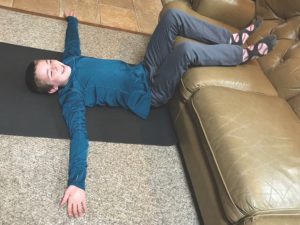
It’s too bad so many of us are taught about good posture as merely a matter of virtue or aesthetics. Good posture is actually a matter of good health, starting with the fact that it reduces strain on your muscles and ligaments while positioning your joints correctly for movement.
Most people know that poor alignment can result in neck and back pain. But other problems that seem unrelated, from tension headaches to impaired digestion to inefficient breathing, have also been linked to poor posture. Recent research shows that the way you carry yourself can even affect your mood and the way that others perceive you. That slouch is associated with depression or lack of confidence.
One version of the slouch I’m seeing a lot of is what physical therapists call “the smartphone slump” — rounded shoulders with the head angled down and forward. The slump is caused by prolonged sitting while engaged in phone or computer activities. It can also be the result of lots of driving.
And it affects children, too. In the past, posture-related health problems were uncommon in young people. Now children are developing issues related to spending so much time in front of screens for homework and for fun.
The first thing to know about improving your posture at any age is that there is not one perfect posture for everyone. And it’s definitely not about standing at attention, straining to hold your shoulders back.
Better posture starts with awareness. Stand in front of a mirror or in a big window for visual feedback as you observe your position. When you stand, look for a straight line from your ear through the middle of your shoulder to your hip and heel. Settle your shoulders at roughly the same height. When you sit, you are looking for the same lines, and your feet should be flat on the floor with knees and hips bent at right angles.
Consider your daily routine. It is easier to stand with good alignment than to sit properly, so try to sit less and move more often. If you’re at your desk for long periods, try setting an alarm to remind you to get up every 30-45 minutes and walk around or stretch. Then there’s the revolutionary idea of reducing your screen time. Put down the phone. And when you’re using it, hold it at eye level, rather than staring down at it.
For your exercise routine, here are my favorite moves aimed at undoing the slump:

If your neck and shoulders are tight, lie on your back with arms stretched out to the sides, palms up. Are you able to rest comfortably on the back of your head without a pillow? If not, start with one or two folded towels under your head. Relax and stay there for 5 to 10 minutes every day.
To strengthen the muscles of the neck and upper back, stand comfortably well-aligned and pinch your shoulder blades together. Now do a chin tuck, pulling your chin back while looking straight forward. No, it’s not a flattering look. Hold for five seconds, then release, and repeat two to three times, several times a day.
Stand in the yoga mountain pose: balance your weight equally on both feet and push your feet down into the floor. Firm your thighs and lengthen your tailbone toward your heels. Now lift your chest straight up, elongating your spine and draw your chin back, balancing your head above your shoulders. Focus on the actions of rooting down into the floor and lengthening upward through your torso. Stay here for 5 to 10 breaths.
If you’re working out at the gym, avoid flexion exercises such as sit-ups and crunches. Instead, you can get a surprisingly good core workout while doing planks. In your plank, work to maintain ear-to-shoulder alignment.
If you have questions about your ability to exercise, consult your health care provide before trying a new routine. And don’t overdo it — good posture should feel good.



